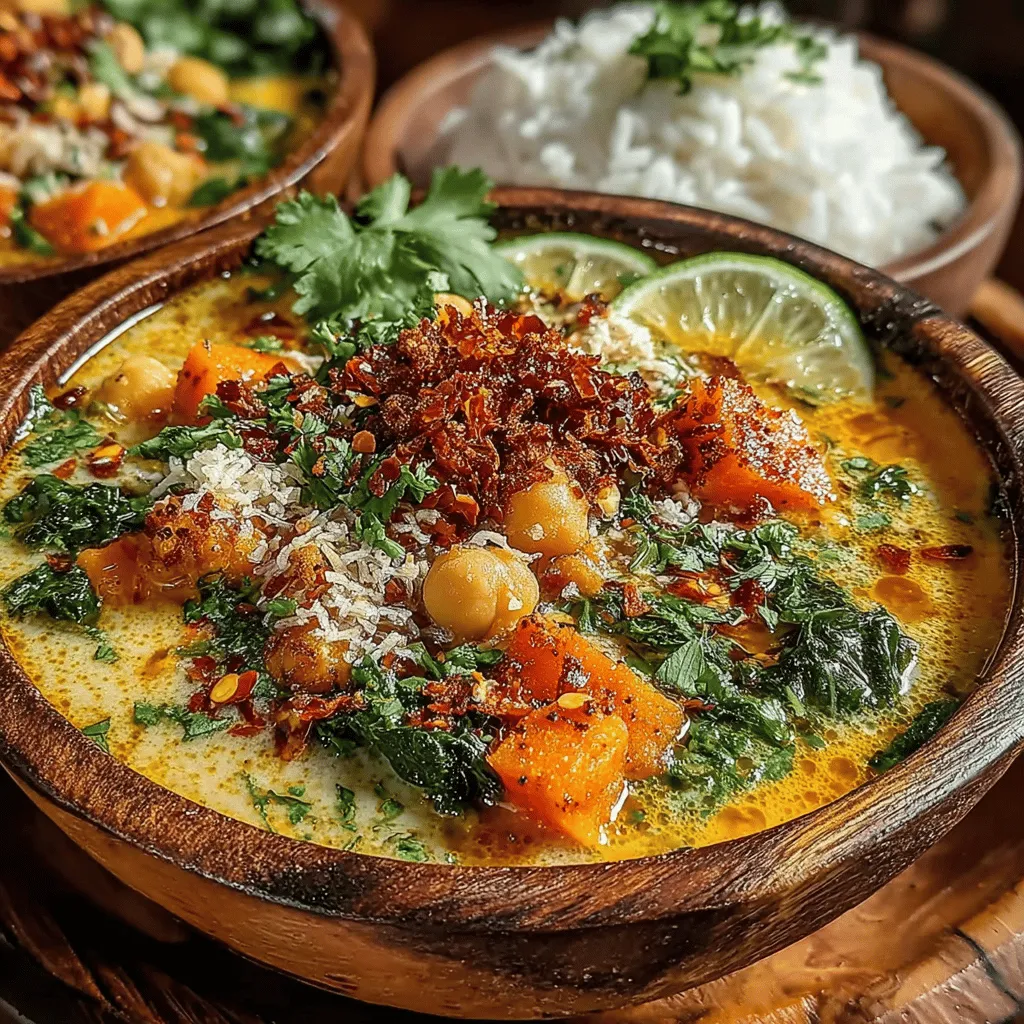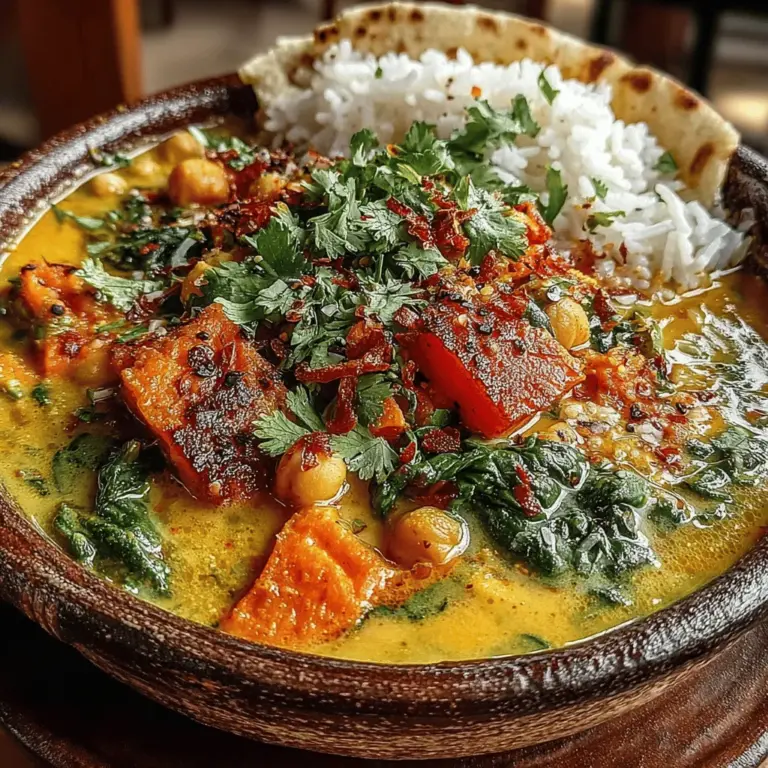Creamy Chickpea & Sweet Potato Coconut Curry Recipe
Introduction
Creamy Chickpea & Sweet Potato Coconut Curry is a delightful dish that beautifully blends flavors, textures, and nutrition. This vegan curry is not only a feast for the senses but also a nourishing option that caters to a variety of dietary preferences. With its vibrant colors and enticing aroma, it captures the essence of comfort food while being entirely plant-based. As more individuals seek to incorporate healthier eating habits into their lives, plant-based meals like this curry have gained significant popularity. They are not only delicious but also promote wellness and sustainability.
The appeal of plant-based meals lies in their ability to provide essential nutrients while being kind to the environment. The combination of chickpeas and sweet potatoes in this recipe offers a perfect balance of protein, fiber, and vitamins, making it an excellent choice for anyone looking to enhance their diet. By using wholesome ingredients such as chickpeas, sweet potatoes, and coconut milk, this curry not only satisfies your taste buds but also supports a balanced lifestyle.
Understanding the Ingredients
To fully appreciate the depth of flavor in Creamy Chickpea & Sweet Potato Coconut Curry, it’s essential to understand the key ingredients that make this dish so special.
Sweet Potatoes: Sweet potatoes are a staple in many healthy diets, known for their sweet, earthy flavor and vibrant orange hue. They are rich in beta-carotene, which the body converts into vitamin A, an essential nutrient for maintaining healthy vision and skin. Additionally, sweet potatoes are an excellent source of complex carbohydrates, providing sustained energy without the blood sugar spikes associated with refined carbs. Their natural sweetness complements the savory elements of the curry, making them a versatile ingredient in both sweet and savory dishes.
Chickpeas: Also known as garbanzo beans, chickpeas are a powerhouse of nutrition, particularly for those following a plant-based diet. They are an excellent source of protein, containing about 15 grams of protein per cooked cup, which makes them a fantastic meat alternative. Chickpeas are also high in fiber, aiding digestion and promoting feelings of fullness. Their nutty flavor and firm texture add depth to the curry, making it hearty and satisfying.
Coconut Milk: The addition of coconut milk elevates this dish to a new level of creaminess and richness. It provides healthy fats, particularly medium-chain triglycerides (MCTs), which are known for their energy-boosting properties. Coconut milk also lends a subtle sweetness that balances the spices in the curry, creating a harmonious flavor profile. Its velvety texture helps to bind the ingredients together, making each spoonful a luxurious experience.
Fresh Spices: Fresh spices such as ginger, garlic, and turmeric are crucial for infusing the curry with flavor and health benefits. Ginger adds a warm, slightly peppery kick that enhances the overall taste, while garlic provides a savory depth that complements the sweetness of the potatoes. Turmeric, known for its anti-inflammatory properties, contributes a beautiful golden color and earthy flavor. Incorporating these spices not only boosts the dish’s taste but also its nutritional value, making it a wholesome option.
Spinach: The inclusion of fresh spinach adds a nutritious green element to the curry. Spinach is loaded with vitamins A, C, and K, as well as iron and calcium, making it an excellent addition to any meal. Its mild flavor allows it to blend seamlessly with the other ingredients, while its vibrant green color adds visual appeal. Including spinach not only enhances the nutritional profile of the dish but also provides a delightful contrast to the creamy texture of the curry.
Health Benefits of Chickpea & Sweet Potato Coconut Curry
Creamy Chickpea & Sweet Potato Coconut Curry is not just a delicious meal; it also offers a myriad of health benefits. The combination of chickpeas and sweet potatoes provides a robust nutritional profile that supports overall health. Chickpeas contribute essential protein, making them a valuable component of a balanced diet, particularly for those who are vegan or vegetarian. The high fiber content in both chickpeas and sweet potatoes aids digestion, helps regulate blood sugar levels, and promotes heart health.
Moreover, the dish is rich in vitamins and minerals, thanks to the inclusion of fresh ingredients and spices. The antioxidants in turmeric and the vitamins in spinach help combat oxidative stress and inflammation in the body, contributing to long-term health. As a gluten-free and vegan dish, it caters to various dietary needs, making it an inclusive option for gatherings and family meals.
Step-by-Step Guide to Making Creamy Chickpea & Sweet Potato Coconut Curry
Now that we’ve explored the enticing ingredients and their benefits, it’s time to dive into the preparation of this delightful curry. This step-by-step guide will ensure you have all the necessary tools and knowledge to create a delicious Creamy Chickpea & Sweet Potato Coconut Curry in your own kitchen.
1. Gather Your Ingredients: Start by assembling all the ingredients you’ll need for the curry. This includes:
– 1 can of chickpeas, drained and rinsed
– 1 large sweet potato, peeled and diced
– 1 can of coconut milk
– 2 cups of fresh spinach
– 1 onion, finely chopped
– 3 cloves of garlic, minced
– 1 tablespoon of fresh ginger, grated
– 1 tablespoon of curry powder
– 1 teaspoon of turmeric
– Olive oil for sautéing
– Salt and pepper to taste
– Fresh cilantro for garnish (optional)
2. Prepare the Vegetables: Begin by peeling and dicing the sweet potato into bite-sized cubes. This will ensure they cook evenly and quickly. Finely chop the onion, and mince the garlic and ginger. Having these ingredients ready will make the cooking process smoother.
3. Sauté the Aromatics: In a large pot or skillet, heat a tablespoon of olive oil over medium heat. Once the oil is hot, add the chopped onion and sauté for about 3-4 minutes, or until it becomes translucent. Next, add the minced garlic and grated ginger, stirring for another minute until fragrant.
4. Add the Spices: Sprinkle in the curry powder and turmeric, stirring to coat the onions, garlic, and ginger. Allow the spices to bloom for about 30 seconds, releasing their essential oils and flavors.
5. Incorporate the Sweet Potatoes: Add the diced sweet potatoes to the pot, stirring to combine with the aromatic mixture. Cook for about 5 minutes, allowing the sweet potatoes to absorb the flavors of the spices.
6. Add the Chickpeas and Coconut Milk: Pour in the drained chickpeas and the can of coconut milk, stirring to combine all the ingredients. Bring the mixture to a gentle simmer, then cover the pot and let it cook for about 15-20 minutes, or until the sweet potatoes are tender.
7. Stir in the Spinach: Once the sweet potatoes are fork-tender, add the fresh spinach to the pot, stirring until it wilts down into the curry. This will add a burst of color and nutrition to your dish.
8. Season to Taste: Finally, season the curry with salt and pepper to taste. Adjust the spices according to your preference, adding more curry powder or turmeric if desired.
With these initial steps, you’re well on your way to creating a delicious and nourishing Creamy Chickpea & Sweet Potato Coconut Curry that will delight your palate and nourish your body. Stay tuned for the next part of this article, where we will explore serving suggestions, variations, and tips to enhance your curry experience.

Importance of Sautéing the Base for Flavor Development
Sautéing the base of your curry is crucial for developing deep, complex flavors. When you start your dish with aromatics like onions, garlic, and ginger, you create a rich foundation that elevates the overall taste. Sautéing these ingredients allows them to caramelize slightly, releasing their natural sugars and enhancing their flavors.
For this Creamy Chickpea & Sweet Potato Coconut Curry, begin by heating a tablespoon of coconut oil in a large pot over medium heat. Add finely chopped onions and sauté until they turn translucent. This process usually takes about 5-7 minutes. Then, introduce minced garlic and grated ginger, cooking for an additional 1-2 minutes until fragrant. This aromatic base is essential, as it sets the stage for the spices and other ingredients that will follow.
Explanation of Spice Incorporation and Its Impact on the Dish
Incorporating spices at the right moment is vital for maximizing their flavor potency. For this curry, you will add spices such as cumin, coriander, turmeric, and garam masala. These spices should be added after your onions, garlic, and ginger have sautéed. Toasting the spices in the hot oil for a minute allows their essential oils to release and bloom, creating an aromatic experience that infuses the entire dish.
Start by adding 1 teaspoon of cumin seeds, 1 teaspoon of ground coriander, 1 teaspoon of turmeric, and 1 teaspoon of garam masala to the pot. Stir these spices in with the sautéed aromatics for about 30 seconds, ensuring they become fragrant. This step not only enhances the flavor profile of the curry but also adds depth and warmth to the dish.
Cooking Techniques for Sweet Potatoes and Chickpeas
Cooking sweet potatoes and chickpeas properly is key to achieving the perfect texture in your curry. For the sweet potatoes, peel and dice them into uniform cubes, roughly 1-inch in size. This ensures even cooking and allows them to absorb the curry’s flavors effectively. Add the diced sweet potatoes to the sautéed base after the spices have been incorporated, stirring well to coat them in the spices.
For the chickpeas, you can use either canned or dried legumes. If using canned chickpeas, simply rinse and drain them before adding them to the pot. If you prefer dried chickpeas, soak them overnight and cook them until tender before incorporating them into the curry.
Stir the chickpeas into the pot along with the sweet potatoes, allowing them to mingle with the spices for a couple of minutes before adding the liquid. This will help enhance their flavor, making every bite delicious.
How to Achieve the Right Consistency of the Curry
The consistency of your curry is essential for a satisfying meal. You want it to be creamy and rich, without being overly thin or too thick. To achieve this, add a can of full-fat coconut milk and enough vegetable broth to cover the sweet potatoes and chickpeas. Typically, about 1 to 1.5 cups of vegetable broth will suffice.
Bring the mixture to a gentle simmer, then reduce the heat to low. Allow it to cook for about 20-25 minutes, or until the sweet potatoes are tender and the curry has thickened slightly. If you find the curry too thin, continue to simmer uncovered to allow it to reduce. If it becomes too thick, simply add a splash more of vegetable broth or coconut milk to reach your desired consistency.
Tips for Effectively Incorporating Greens and Seasonings
Adding greens not only boosts the nutritional content of your curry but also adds a fresh element to the dish. Spinach, kale, or Swiss chard are excellent choices. To incorporate greens effectively, add them during the last 5 minutes of cooking. This timing ensures they wilt and retain their vibrant color without becoming overcooked.
To season your curry perfectly, taste it towards the end of cooking and adjust the seasoning as necessary. A pinch of salt can elevate the flavors, while a squeeze of lime juice brightens the dish. Remember, the balance of flavors is key, so don’t hesitate to tweak the seasoning until it suits your palate.
Flavor Variations and Customizations
One of the beauties of this creamy chickpea and sweet potato coconut curry is its versatility. Here are some suggestions for ingredient swaps and customizations:
Suggestions for Ingredient Swaps
– Vegetables: Feel free to replace sweet potatoes with other root vegetables such as carrots or parsnips. You can also add bell peppers, zucchini, or cauliflower for a different texture and flavor.
– Legumes: If chickpeas aren’t your favorite, try using lentils or black beans for a protein boost.
Alternative Spices to Experiment With
– Curry Powder: Instead of using individual spices, a good-quality curry powder can simplify the process and still deliver a robust flavor.
– Chili Powder or Fresh Chilies: For those who enjoy heat, adding chili powder or fresh chilies can elevate the dish to new spice levels.
Ideas for Serving Accompaniments
Pair your curry with fluffy basmati rice or quinoa to soak up the delicious sauce. Alternatively, serve it with warm naan or roti for a comforting meal. You can also consider a side of cooling cucumber raita to balance the flavors if you opt for a spicier version of the curry.
Pairing Suggestions
To enhance the meal experience, consider these recommended side dishes and beverage pairings:
Recommended Side Dishes that Complement the Curry
– Cucumber Salad: A refreshing cucumber salad with lime juice and cilantro can provide a light contrast to the richness of the curry.
– Roasted Cauliflower: Spiced roasted cauliflower can add a delightful crunch and additional flavor profile to your meal.
Beverage Pairings that Enhance the Meal Experience
– Coconut Water: A refreshing glass of coconut water complements the curry’s tropical flavors.
– Chai Tea: For a warm beverage option, a cup of chai tea offers a spiced counterpart to your meal.
Storage and Reheating Tips
If you have leftovers, here are some best practices for storing and reheating your creamy chickpea and sweet potato coconut curry:
Best Practices for Storing Leftovers
– Refrigeration: Allow the curry to cool completely before transferring it to an airtight container. It can be stored in the refrigerator for up to 4 days.
– Freezing: For longer storage, you can freeze the curry. Portion it into freezer-safe containers and store for up to 3 months. Thaw overnight in the refrigerator before reheating.
How to Reheat the Curry Without Compromising Flavor and Texture
To reheat, place the curry in a saucepan over low heat. Stir occasionally while it warms up to ensure it heats evenly. If the curry seems too thick after refrigeration or freezing, add a splash of coconut milk or broth to achieve your desired consistency. Avoid microwaving if possible, as it can lead to uneven heating and a change in texture.
Conclusion
This Creamy Chickpea & Sweet Potato Coconut Curry is not only a flavorful dish but also a nourishing option packed with plant-based protein, fiber, and vitamins. Its creamy texture and blend of spices make it a comforting meal that will satisfy both vegetarians and meat lovers alike.
With endless possibilities for customization, this recipe invites you to get creative in the kitchen. Whether you stick to the classic ingredients or experiment with different vegetables and spices, you are sure to enjoy a delicious, wholesome meal. We encourage you to try this recipe and experience the delightful flavors and health benefits of this plant-based curry. Your taste buds will thank you!

